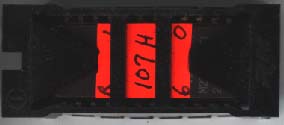 I'm probably not familiar with that programmer (there's lots of them out there). Anything in the $150-$200 range (new) is the best to expect. You also will want to consider whether you want the programmer to be connected via a serial/parallel port or to an adapter card the plugs inside your computer (assuming you have an IBM-compatible). I prefer the external-only units that can copy without the computer since I travel with mine sometimes, but that type costs more. I think the internal units, though, transfer data to/from the programmer faster. (Even with Motorola S Hex format, it still takes only about 20 seconds to download at 19.2K Baud on my old Data I/O programmer.)
I'm probably not familiar with that programmer (there's lots of them out there). Anything in the $150-$200 range (new) is the best to expect. You also will want to consider whether you want the programmer to be connected via a serial/parallel port or to an adapter card the plugs inside your computer (assuming you have an IBM-compatible). I prefer the external-only units that can copy without the computer since I travel with mine sometimes, but that type costs more. I think the internal units, though, transfer data to/from the programmer faster. (Even with Motorola S Hex format, it still takes only about 20 seconds to download at 19.2K Baud on my old Data I/O programmer.)If a PROM already has a program stored, then it must first be erased using a PROM eraser device having a special ultraviolet (UV) light designed for erasing PROMs. The PROMs are placed in the eraser for 15-25 minutes, the duration depending on the intensity of the light and distance from the UV bulb. The PROMs can then immediately be reprogrammed.
PROMs of the 2732A type can be reprogrammed on the order of 5000 to 10000 times. So, if you buy them new, you'll never have to be concerned about reprogramming too many times. This also means that working used PROMs are an inexpensive alternative to buying new ones.
Also, Fry's electronics in California is frequently mentioned on the net as an inexpensive source of components.
Next, check the orientation of the PROM relative to the carrier - the PROM must be placed in the carrier with both notches on the same end. The carrier will have a rectangular notch in the middle of the handle on one end. The PROM will have a small round notch in the middle of one end.
Then, place the plastic carrier top down (open side up) on a table. Center the PROM over the middle of the bottom of the plastic carrier, with the PROM pins pointed up. Using both thumbs next to each other on the center bottom of the PROM, press downward firmly until the pins are about 1 mm (1/32") below the ridge of the plastic carrier. The PROM will have been placed correctly if it snaps into place and stays put without continual pressure.
Method #1: First, ground yourself. Then hold each side of the carrier between the thumb and fore finger, with the bottom of the chip facing up. Use each thumb to pry apart the sides of the plastic carrier about 1/8 to 3/16 inches on each side. The PROM will pop up on one or both sides. Use a small screw driver or other tool to push the PROM out from the top of the carrier.
If the PROM leads don't pop out enough on at least one side, just push the PROM back into the carrier as follows and try again. Place the PROM and carrier upside down on a solid surface (touch the surface and a ground in that order first). Press on the center of the PROM until the ends of the PROM leads are just below the top of the carrier. The PROM should stay seated; if not, push down just a little more.
Method #2: First, ground yourself. Place the carrier upside down on a solid surface (touch the surface and a ground in that order first). Using an 1157 or identical-sized automotive tail/brake light bulb, run the bulb portion from one end of the bottom side of the carrier to the other. Press hard enough so that the sides of the carrier spread about 1/8 inches on each side, a little more as the bulb passes the center of carrier. With a little practice the PROM will pop up 3/16 inches on both sides. Use a small screw driver or other tool to push the PROM out from the top of the carrier.